Strategic Analysis of Royal Bank of Canada: A Comprehensive Report
VerifiedAdded on 2023/01/19
|10
|1965
|47
Report
AI Summary
This report provides a strategic analysis of the Royal Bank of Canada (RBC). It begins with a summary of RBC's mission, vision, and core values, highlighting its position in the financial sector. The report then delves into a SWOT analysis, examining RBC's strengths (e.g., strong dealer relationships), weaknesses (e.g., less R&D investment), opportunities (e.g., e-commerce integration), and threats (e.g., market competition). The analysis extends to environmental constraints using the PESTLE model, evaluating political, economic, social, technological, legal, and environmental factors impacting RBC's operations. The report identifies key stakeholders, including employees, customers, investors, and regulators, and discusses RBC's flat organizational structure and employee motivation strategies based on Maslow's theory. Finally, it recommends feedback and feedforward controls for monitoring progress and maintaining a positive business image.
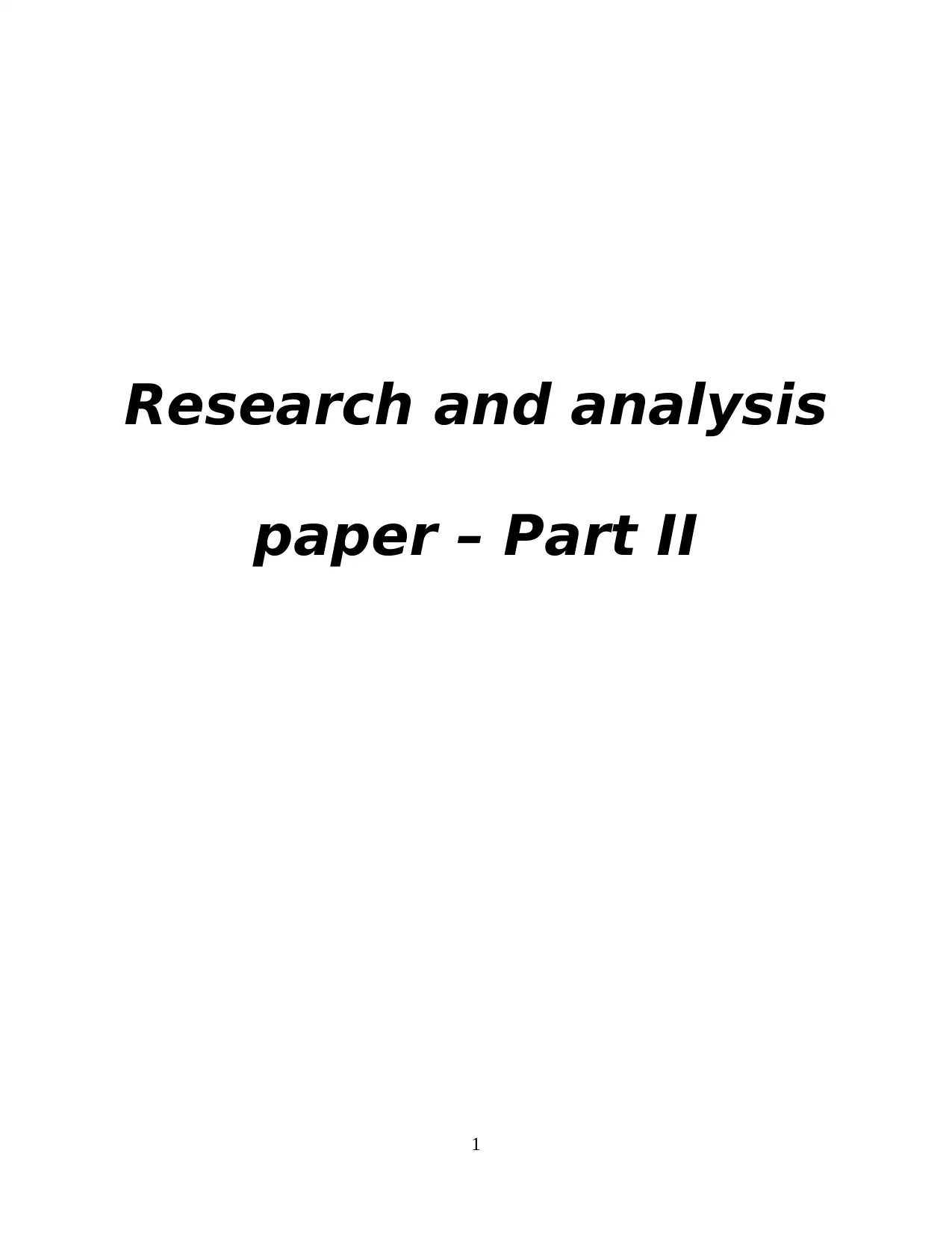
Research and analysis
paper – Part II
1
paper – Part II
1
Paraphrase This Document
Need a fresh take? Get an instant paraphrase of this document with our AI Paraphraser
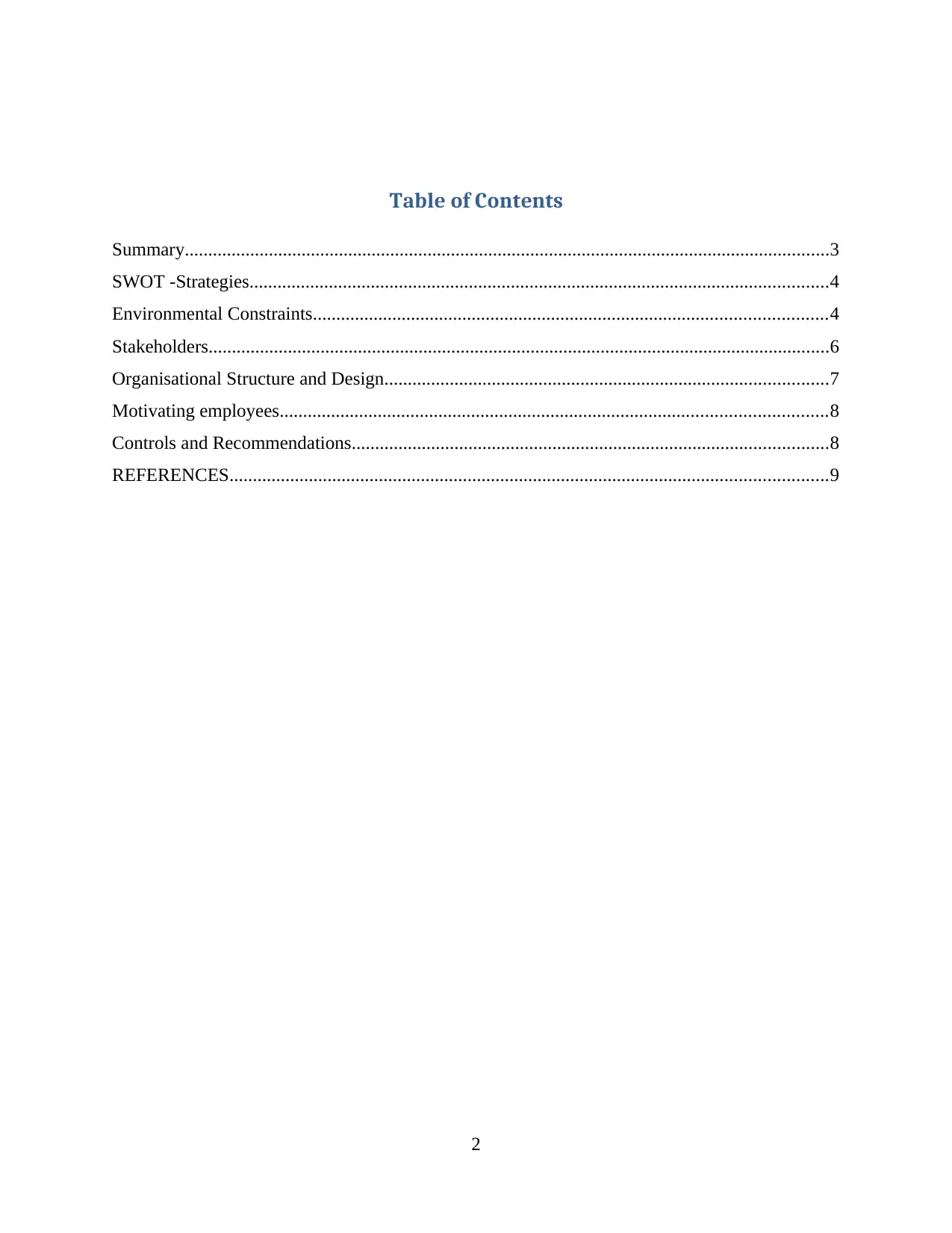
Table of Contents
Summary..........................................................................................................................................3
SWOT -Strategies............................................................................................................................4
Environmental Constraints..............................................................................................................4
Stakeholders.....................................................................................................................................6
Organisational Structure and Design...............................................................................................7
Motivating employees.....................................................................................................................8
Controls and Recommendations......................................................................................................8
REFERENCES................................................................................................................................9
2
Summary..........................................................................................................................................3
SWOT -Strategies............................................................................................................................4
Environmental Constraints..............................................................................................................4
Stakeholders.....................................................................................................................................6
Organisational Structure and Design...............................................................................................7
Motivating employees.....................................................................................................................8
Controls and Recommendations......................................................................................................8
REFERENCES................................................................................................................................9
2
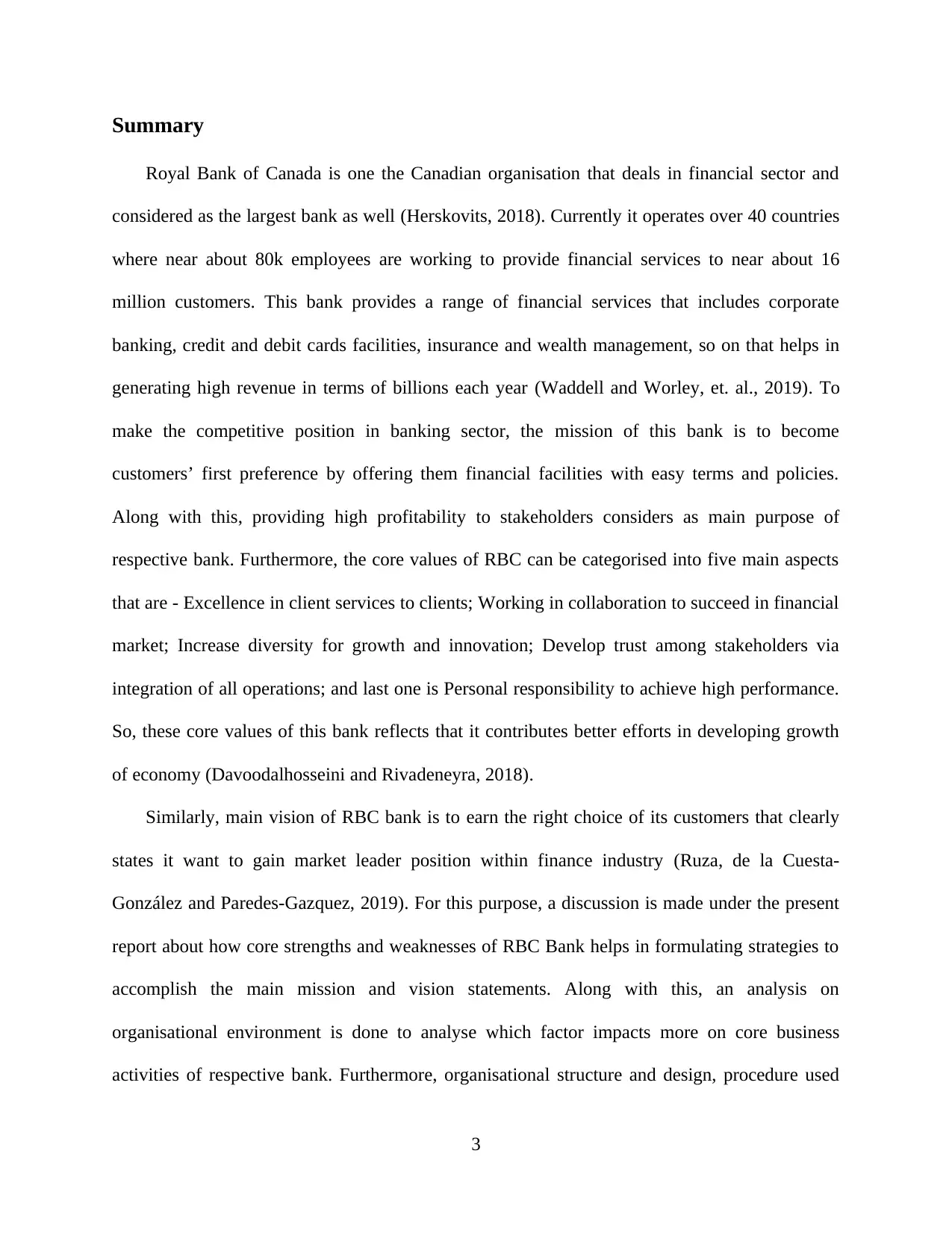
Summary
Royal Bank of Canada is one the Canadian organisation that deals in financial sector and
considered as the largest bank as well (Herskovits, 2018). Currently it operates over 40 countries
where near about 80k employees are working to provide financial services to near about 16
million customers. This bank provides a range of financial services that includes corporate
banking, credit and debit cards facilities, insurance and wealth management, so on that helps in
generating high revenue in terms of billions each year (Waddell and Worley, et. al., 2019). To
make the competitive position in banking sector, the mission of this bank is to become
customers’ first preference by offering them financial facilities with easy terms and policies.
Along with this, providing high profitability to stakeholders considers as main purpose of
respective bank. Furthermore, the core values of RBC can be categorised into five main aspects
that are - Excellence in client services to clients; Working in collaboration to succeed in financial
market; Increase diversity for growth and innovation; Develop trust among stakeholders via
integration of all operations; and last one is Personal responsibility to achieve high performance.
So, these core values of this bank reflects that it contributes better efforts in developing growth
of economy (Davoodalhosseini and Rivadeneyra, 2018).
Similarly, main vision of RBC bank is to earn the right choice of its customers that clearly
states it want to gain market leader position within finance industry (Ruza, de la Cuesta-
González and Paredes-Gazquez, 2019). For this purpose, a discussion is made under the present
report about how core strengths and weaknesses of RBC Bank helps in formulating strategies to
accomplish the main mission and vision statements. Along with this, an analysis on
organisational environment is done to analyse which factor impacts more on core business
activities of respective bank. Furthermore, organisational structure and design, procedure used
3
Royal Bank of Canada is one the Canadian organisation that deals in financial sector and
considered as the largest bank as well (Herskovits, 2018). Currently it operates over 40 countries
where near about 80k employees are working to provide financial services to near about 16
million customers. This bank provides a range of financial services that includes corporate
banking, credit and debit cards facilities, insurance and wealth management, so on that helps in
generating high revenue in terms of billions each year (Waddell and Worley, et. al., 2019). To
make the competitive position in banking sector, the mission of this bank is to become
customers’ first preference by offering them financial facilities with easy terms and policies.
Along with this, providing high profitability to stakeholders considers as main purpose of
respective bank. Furthermore, the core values of RBC can be categorised into five main aspects
that are - Excellence in client services to clients; Working in collaboration to succeed in financial
market; Increase diversity for growth and innovation; Develop trust among stakeholders via
integration of all operations; and last one is Personal responsibility to achieve high performance.
So, these core values of this bank reflects that it contributes better efforts in developing growth
of economy (Davoodalhosseini and Rivadeneyra, 2018).
Similarly, main vision of RBC bank is to earn the right choice of its customers that clearly
states it want to gain market leader position within finance industry (Ruza, de la Cuesta-
González and Paredes-Gazquez, 2019). For this purpose, a discussion is made under the present
report about how core strengths and weaknesses of RBC Bank helps in formulating strategies to
accomplish the main mission and vision statements. Along with this, an analysis on
organisational environment is done to analyse which factor impacts more on core business
activities of respective bank. Furthermore, organisational structure and design, procedure used
3
⊘ This is a preview!⊘
Do you want full access?
Subscribe today to unlock all pages.

Trusted by 1+ million students worldwide
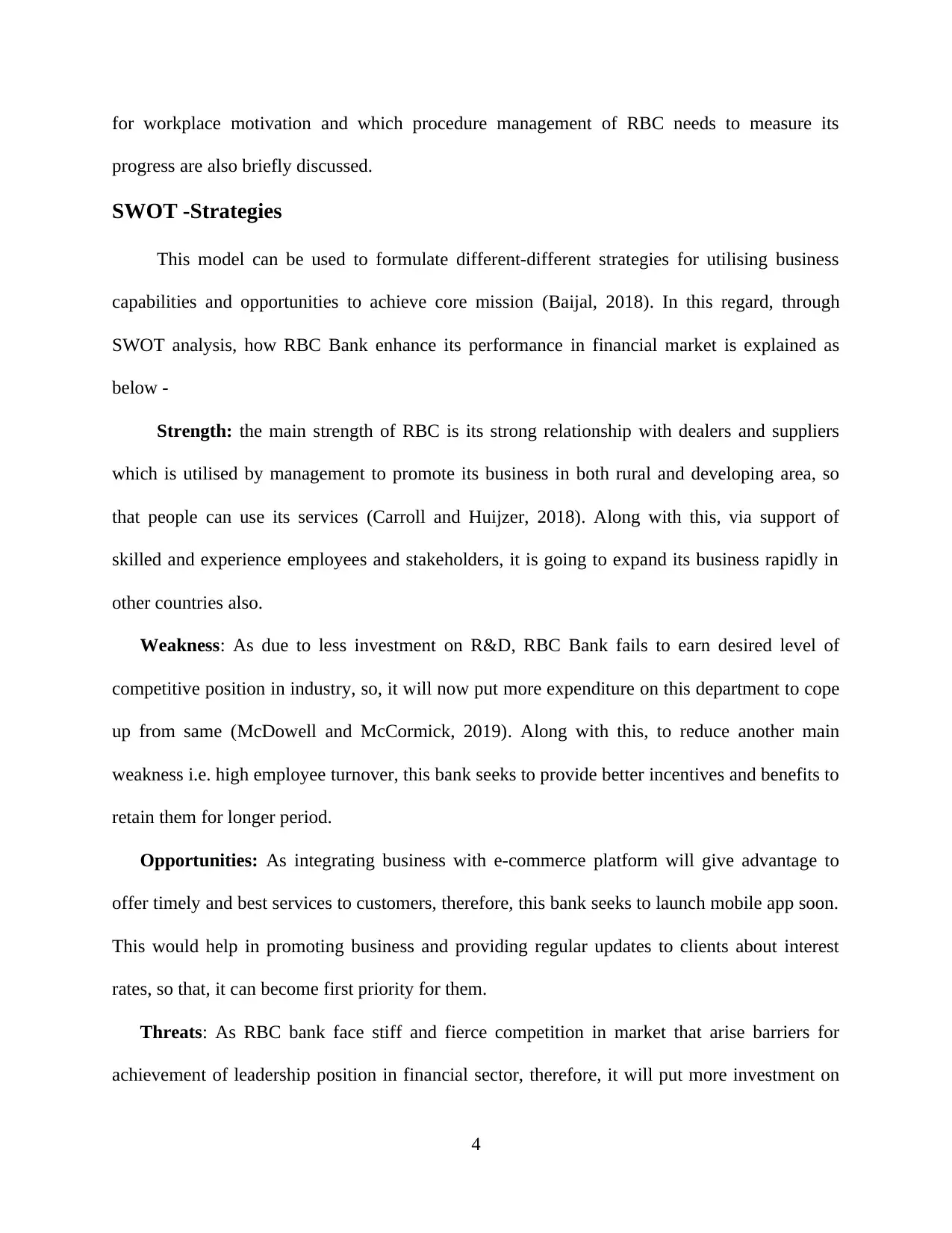
for workplace motivation and which procedure management of RBC needs to measure its
progress are also briefly discussed.
SWOT -Strategies
This model can be used to formulate different-different strategies for utilising business
capabilities and opportunities to achieve core mission (Baijal, 2018). In this regard, through
SWOT analysis, how RBC Bank enhance its performance in financial market is explained as
below -
Strength: the main strength of RBC is its strong relationship with dealers and suppliers
which is utilised by management to promote its business in both rural and developing area, so
that people can use its services (Carroll and Huijzer, 2018). Along with this, via support of
skilled and experience employees and stakeholders, it is going to expand its business rapidly in
other countries also.
Weakness: As due to less investment on R&D, RBC Bank fails to earn desired level of
competitive position in industry, so, it will now put more expenditure on this department to cope
up from same (McDowell and McCormick, 2019). Along with this, to reduce another main
weakness i.e. high employee turnover, this bank seeks to provide better incentives and benefits to
retain them for longer period.
Opportunities: As integrating business with e-commerce platform will give advantage to
offer timely and best services to customers, therefore, this bank seeks to launch mobile app soon.
This would help in promoting business and providing regular updates to clients about interest
rates, so that, it can become first priority for them.
Threats: As RBC bank face stiff and fierce competition in market that arise barriers for
achievement of leadership position in financial sector, therefore, it will put more investment on
4
progress are also briefly discussed.
SWOT -Strategies
This model can be used to formulate different-different strategies for utilising business
capabilities and opportunities to achieve core mission (Baijal, 2018). In this regard, through
SWOT analysis, how RBC Bank enhance its performance in financial market is explained as
below -
Strength: the main strength of RBC is its strong relationship with dealers and suppliers
which is utilised by management to promote its business in both rural and developing area, so
that people can use its services (Carroll and Huijzer, 2018). Along with this, via support of
skilled and experience employees and stakeholders, it is going to expand its business rapidly in
other countries also.
Weakness: As due to less investment on R&D, RBC Bank fails to earn desired level of
competitive position in industry, so, it will now put more expenditure on this department to cope
up from same (McDowell and McCormick, 2019). Along with this, to reduce another main
weakness i.e. high employee turnover, this bank seeks to provide better incentives and benefits to
retain them for longer period.
Opportunities: As integrating business with e-commerce platform will give advantage to
offer timely and best services to customers, therefore, this bank seeks to launch mobile app soon.
This would help in promoting business and providing regular updates to clients about interest
rates, so that, it can become first priority for them.
Threats: As RBC bank face stiff and fierce competition in market that arise barriers for
achievement of leadership position in financial sector, therefore, it will put more investment on
4
Paraphrase This Document
Need a fresh take? Get an instant paraphrase of this document with our AI Paraphraser
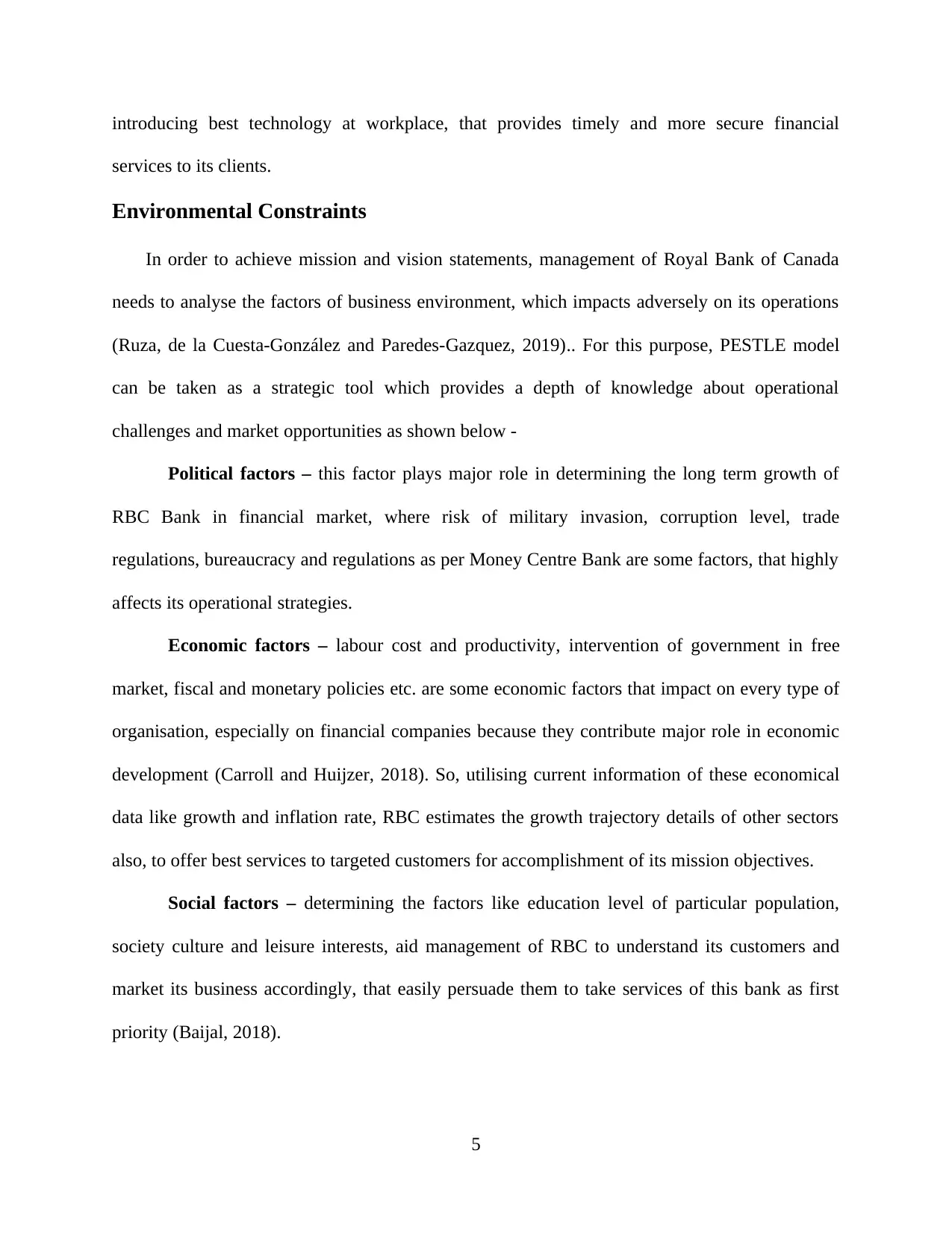
introducing best technology at workplace, that provides timely and more secure financial
services to its clients.
Environmental Constraints
In order to achieve mission and vision statements, management of Royal Bank of Canada
needs to analyse the factors of business environment, which impacts adversely on its operations
(Ruza, de la Cuesta-González and Paredes-Gazquez, 2019).. For this purpose, PESTLE model
can be taken as a strategic tool which provides a depth of knowledge about operational
challenges and market opportunities as shown below -
Political factors – this factor plays major role in determining the long term growth of
RBC Bank in financial market, where risk of military invasion, corruption level, trade
regulations, bureaucracy and regulations as per Money Centre Bank are some factors, that highly
affects its operational strategies.
Economic factors – labour cost and productivity, intervention of government in free
market, fiscal and monetary policies etc. are some economic factors that impact on every type of
organisation, especially on financial companies because they contribute major role in economic
development (Carroll and Huijzer, 2018). So, utilising current information of these economical
data like growth and inflation rate, RBC estimates the growth trajectory details of other sectors
also, to offer best services to targeted customers for accomplishment of its mission objectives.
Social factors – determining the factors like education level of particular population,
society culture and leisure interests, aid management of RBC to understand its customers and
market its business accordingly, that easily persuade them to take services of this bank as first
priority (Baijal, 2018).
5
services to its clients.
Environmental Constraints
In order to achieve mission and vision statements, management of Royal Bank of Canada
needs to analyse the factors of business environment, which impacts adversely on its operations
(Ruza, de la Cuesta-González and Paredes-Gazquez, 2019).. For this purpose, PESTLE model
can be taken as a strategic tool which provides a depth of knowledge about operational
challenges and market opportunities as shown below -
Political factors – this factor plays major role in determining the long term growth of
RBC Bank in financial market, where risk of military invasion, corruption level, trade
regulations, bureaucracy and regulations as per Money Centre Bank are some factors, that highly
affects its operational strategies.
Economic factors – labour cost and productivity, intervention of government in free
market, fiscal and monetary policies etc. are some economic factors that impact on every type of
organisation, especially on financial companies because they contribute major role in economic
development (Carroll and Huijzer, 2018). So, utilising current information of these economical
data like growth and inflation rate, RBC estimates the growth trajectory details of other sectors
also, to offer best services to targeted customers for accomplishment of its mission objectives.
Social factors – determining the factors like education level of particular population,
society culture and leisure interests, aid management of RBC to understand its customers and
market its business accordingly, that easily persuade them to take services of this bank as first
priority (Baijal, 2018).
5
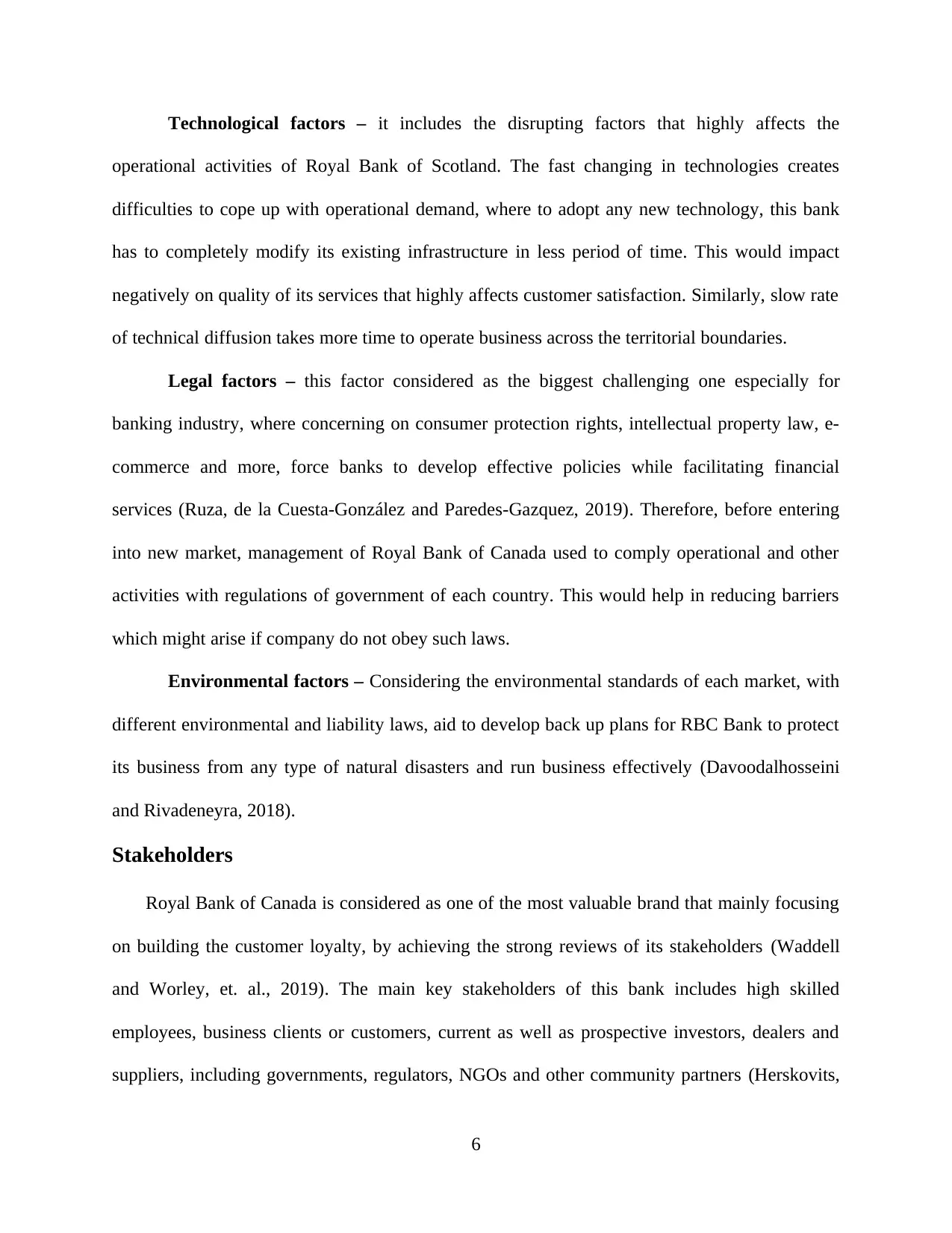
Technological factors – it includes the disrupting factors that highly affects the
operational activities of Royal Bank of Scotland. The fast changing in technologies creates
difficulties to cope up with operational demand, where to adopt any new technology, this bank
has to completely modify its existing infrastructure in less period of time. This would impact
negatively on quality of its services that highly affects customer satisfaction. Similarly, slow rate
of technical diffusion takes more time to operate business across the territorial boundaries.
Legal factors – this factor considered as the biggest challenging one especially for
banking industry, where concerning on consumer protection rights, intellectual property law, e-
commerce and more, force banks to develop effective policies while facilitating financial
services (Ruza, de la Cuesta-González and Paredes-Gazquez, 2019). Therefore, before entering
into new market, management of Royal Bank of Canada used to comply operational and other
activities with regulations of government of each country. This would help in reducing barriers
which might arise if company do not obey such laws.
Environmental factors – Considering the environmental standards of each market, with
different environmental and liability laws, aid to develop back up plans for RBC Bank to protect
its business from any type of natural disasters and run business effectively (Davoodalhosseini
and Rivadeneyra, 2018).
Stakeholders
Royal Bank of Canada is considered as one of the most valuable brand that mainly focusing
on building the customer loyalty, by achieving the strong reviews of its stakeholders (Waddell
and Worley, et. al., 2019). The main key stakeholders of this bank includes high skilled
employees, business clients or customers, current as well as prospective investors, dealers and
suppliers, including governments, regulators, NGOs and other community partners (Herskovits,
6
operational activities of Royal Bank of Scotland. The fast changing in technologies creates
difficulties to cope up with operational demand, where to adopt any new technology, this bank
has to completely modify its existing infrastructure in less period of time. This would impact
negatively on quality of its services that highly affects customer satisfaction. Similarly, slow rate
of technical diffusion takes more time to operate business across the territorial boundaries.
Legal factors – this factor considered as the biggest challenging one especially for
banking industry, where concerning on consumer protection rights, intellectual property law, e-
commerce and more, force banks to develop effective policies while facilitating financial
services (Ruza, de la Cuesta-González and Paredes-Gazquez, 2019). Therefore, before entering
into new market, management of Royal Bank of Canada used to comply operational and other
activities with regulations of government of each country. This would help in reducing barriers
which might arise if company do not obey such laws.
Environmental factors – Considering the environmental standards of each market, with
different environmental and liability laws, aid to develop back up plans for RBC Bank to protect
its business from any type of natural disasters and run business effectively (Davoodalhosseini
and Rivadeneyra, 2018).
Stakeholders
Royal Bank of Canada is considered as one of the most valuable brand that mainly focusing
on building the customer loyalty, by achieving the strong reviews of its stakeholders (Waddell
and Worley, et. al., 2019). The main key stakeholders of this bank includes high skilled
employees, business clients or customers, current as well as prospective investors, dealers and
suppliers, including governments, regulators, NGOs and other community partners (Herskovits,
6
⊘ This is a preview!⊘
Do you want full access?
Subscribe today to unlock all pages.

Trusted by 1+ million students worldwide
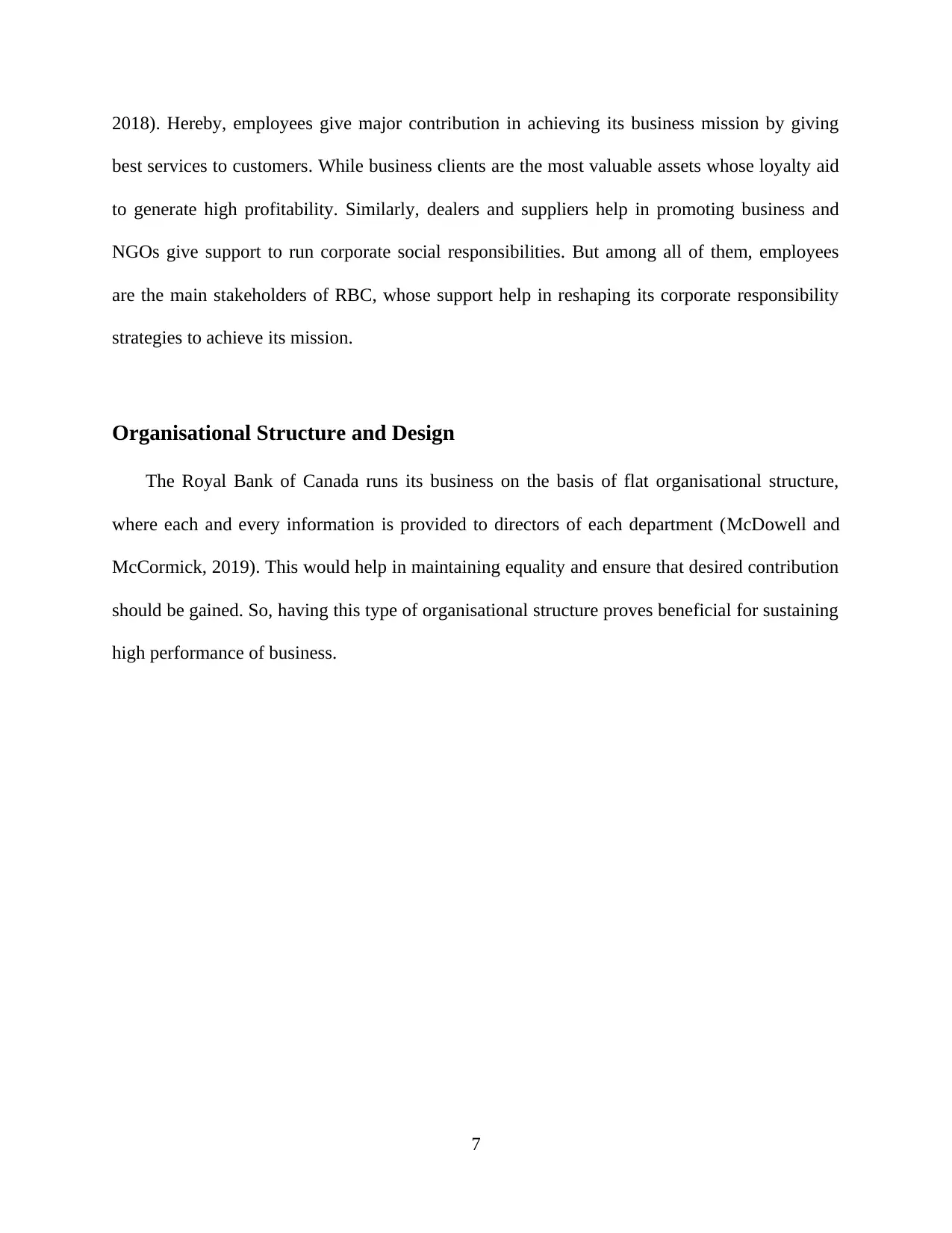
2018). Hereby, employees give major contribution in achieving its business mission by giving
best services to customers. While business clients are the most valuable assets whose loyalty aid
to generate high profitability. Similarly, dealers and suppliers help in promoting business and
NGOs give support to run corporate social responsibilities. But among all of them, employees
are the main stakeholders of RBC, whose support help in reshaping its corporate responsibility
strategies to achieve its mission.
Organisational Structure and Design
The Royal Bank of Canada runs its business on the basis of flat organisational structure,
where each and every information is provided to directors of each department (McDowell and
McCormick, 2019). This would help in maintaining equality and ensure that desired contribution
should be gained. So, having this type of organisational structure proves beneficial for sustaining
high performance of business.
7
best services to customers. While business clients are the most valuable assets whose loyalty aid
to generate high profitability. Similarly, dealers and suppliers help in promoting business and
NGOs give support to run corporate social responsibilities. But among all of them, employees
are the main stakeholders of RBC, whose support help in reshaping its corporate responsibility
strategies to achieve its mission.
Organisational Structure and Design
The Royal Bank of Canada runs its business on the basis of flat organisational structure,
where each and every information is provided to directors of each department (McDowell and
McCormick, 2019). This would help in maintaining equality and ensure that desired contribution
should be gained. So, having this type of organisational structure proves beneficial for sustaining
high performance of business.
7
Paraphrase This Document
Need a fresh take? Get an instant paraphrase of this document with our AI Paraphraser
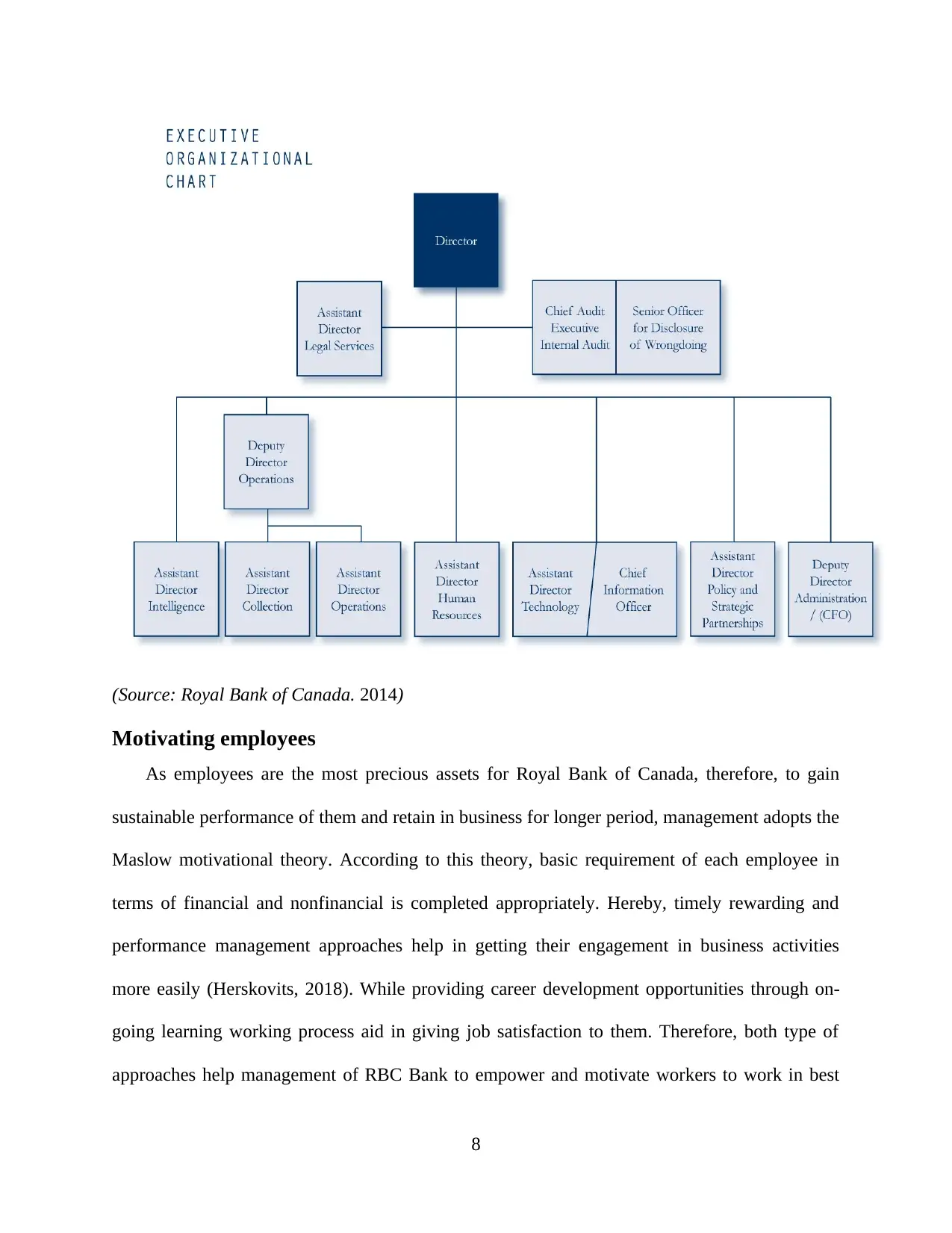
(Source: Royal Bank of Canada. 2014)
Motivating employees
As employees are the most precious assets for Royal Bank of Canada, therefore, to gain
sustainable performance of them and retain in business for longer period, management adopts the
Maslow motivational theory. According to this theory, basic requirement of each employee in
terms of financial and nonfinancial is completed appropriately. Hereby, timely rewarding and
performance management approaches help in getting their engagement in business activities
more easily (Herskovits, 2018). While providing career development opportunities through on-
going learning working process aid in giving job satisfaction to them. Therefore, both type of
approaches help management of RBC Bank to empower and motivate workers to work in best
8
Motivating employees
As employees are the most precious assets for Royal Bank of Canada, therefore, to gain
sustainable performance of them and retain in business for longer period, management adopts the
Maslow motivational theory. According to this theory, basic requirement of each employee in
terms of financial and nonfinancial is completed appropriately. Hereby, timely rewarding and
performance management approaches help in getting their engagement in business activities
more easily (Herskovits, 2018). While providing career development opportunities through on-
going learning working process aid in giving job satisfaction to them. Therefore, both type of
approaches help management of RBC Bank to empower and motivate workers to work in best
8
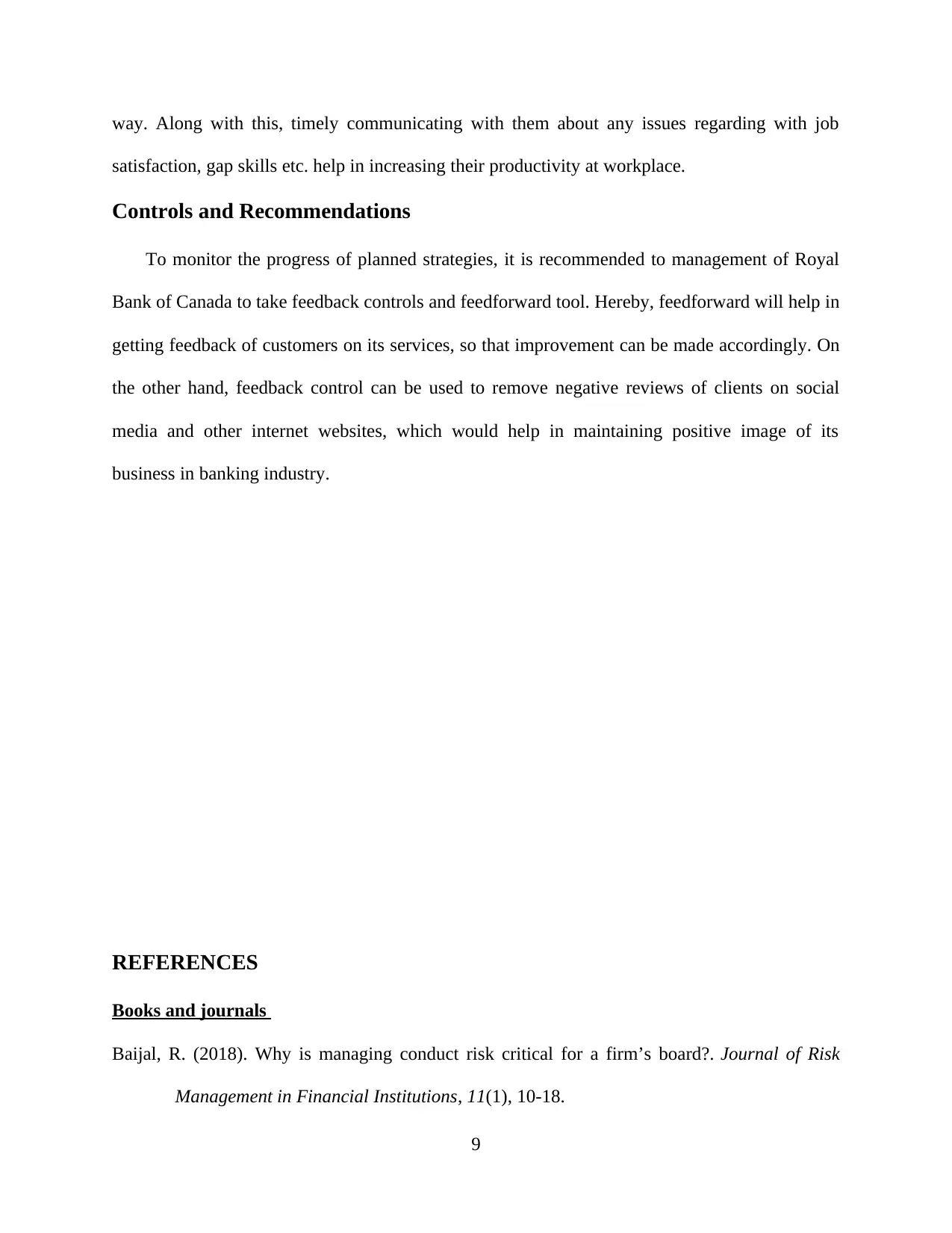
way. Along with this, timely communicating with them about any issues regarding with job
satisfaction, gap skills etc. help in increasing their productivity at workplace.
Controls and Recommendations
To monitor the progress of planned strategies, it is recommended to management of Royal
Bank of Canada to take feedback controls and feedforward tool. Hereby, feedforward will help in
getting feedback of customers on its services, so that improvement can be made accordingly. On
the other hand, feedback control can be used to remove negative reviews of clients on social
media and other internet websites, which would help in maintaining positive image of its
business in banking industry.
REFERENCES
Books and journals
Baijal, R. (2018). Why is managing conduct risk critical for a firm’s board?. Journal of Risk
Management in Financial Institutions, 11(1), 10-18.
9
satisfaction, gap skills etc. help in increasing their productivity at workplace.
Controls and Recommendations
To monitor the progress of planned strategies, it is recommended to management of Royal
Bank of Canada to take feedback controls and feedforward tool. Hereby, feedforward will help in
getting feedback of customers on its services, so that improvement can be made accordingly. On
the other hand, feedback control can be used to remove negative reviews of clients on social
media and other internet websites, which would help in maintaining positive image of its
business in banking industry.
REFERENCES
Books and journals
Baijal, R. (2018). Why is managing conduct risk critical for a firm’s board?. Journal of Risk
Management in Financial Institutions, 11(1), 10-18.
9
⊘ This is a preview!⊘
Do you want full access?
Subscribe today to unlock all pages.

Trusted by 1+ million students worldwide
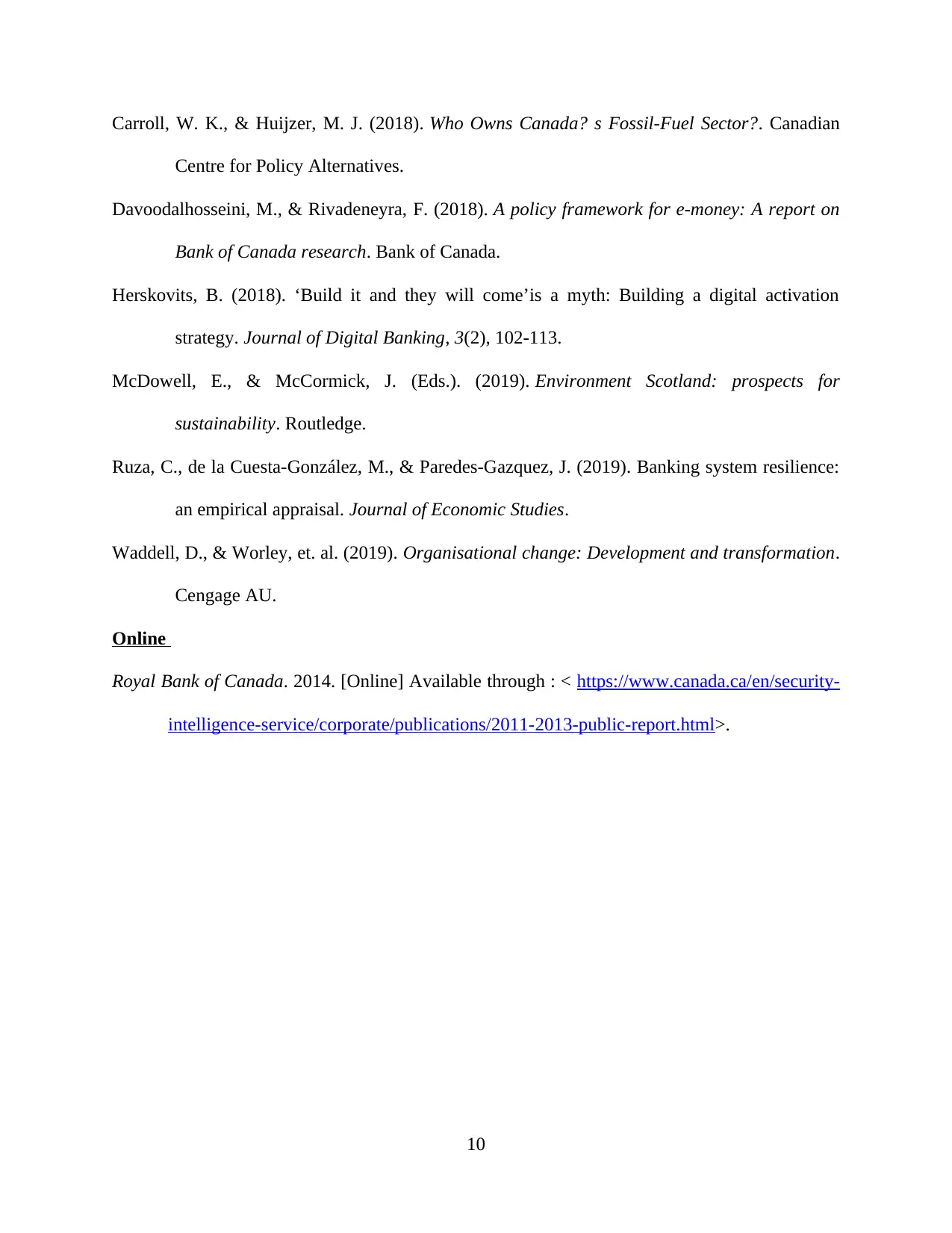
Carroll, W. K., & Huijzer, M. J. (2018). Who Owns Canada? s Fossil-Fuel Sector?. Canadian
Centre for Policy Alternatives.
Davoodalhosseini, M., & Rivadeneyra, F. (2018). A policy framework for e-money: A report on
Bank of Canada research. Bank of Canada.
Herskovits, B. (2018). ‘Build it and they will come’is a myth: Building a digital activation
strategy. Journal of Digital Banking, 3(2), 102-113.
McDowell, E., & McCormick, J. (Eds.). (2019). Environment Scotland: prospects for
sustainability. Routledge.
Ruza, C., de la Cuesta-González, M., & Paredes-Gazquez, J. (2019). Banking system resilience:
an empirical appraisal. Journal of Economic Studies.
Waddell, D., & Worley, et. al. (2019). Organisational change: Development and transformation.
Cengage AU.
Online
Royal Bank of Canada. 2014. [Online] Available through : < https://www.canada.ca/en/security-
intelligence-service/corporate/publications/2011-2013-public-report.html>.
10
Centre for Policy Alternatives.
Davoodalhosseini, M., & Rivadeneyra, F. (2018). A policy framework for e-money: A report on
Bank of Canada research. Bank of Canada.
Herskovits, B. (2018). ‘Build it and they will come’is a myth: Building a digital activation
strategy. Journal of Digital Banking, 3(2), 102-113.
McDowell, E., & McCormick, J. (Eds.). (2019). Environment Scotland: prospects for
sustainability. Routledge.
Ruza, C., de la Cuesta-González, M., & Paredes-Gazquez, J. (2019). Banking system resilience:
an empirical appraisal. Journal of Economic Studies.
Waddell, D., & Worley, et. al. (2019). Organisational change: Development and transformation.
Cengage AU.
Online
Royal Bank of Canada. 2014. [Online] Available through : < https://www.canada.ca/en/security-
intelligence-service/corporate/publications/2011-2013-public-report.html>.
10
1 out of 10
Related Documents
Your All-in-One AI-Powered Toolkit for Academic Success.
+13062052269
info@desklib.com
Available 24*7 on WhatsApp / Email
![[object Object]](/_next/static/media/star-bottom.7253800d.svg)
Unlock your academic potential
Copyright © 2020–2025 A2Z Services. All Rights Reserved. Developed and managed by ZUCOL.





